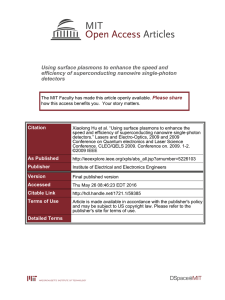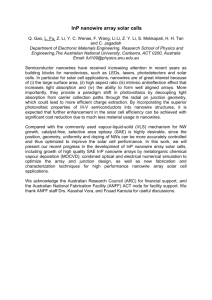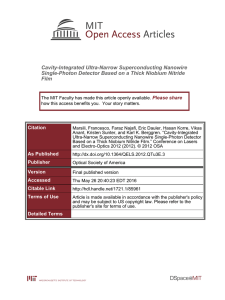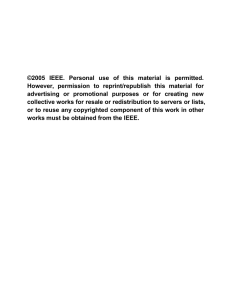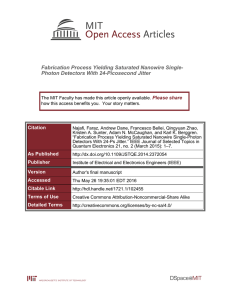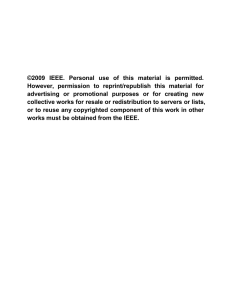Mid-Infrared Single-Photon Detection Using Superconducting Nanowires Integrated with Nano- Antennae Please share
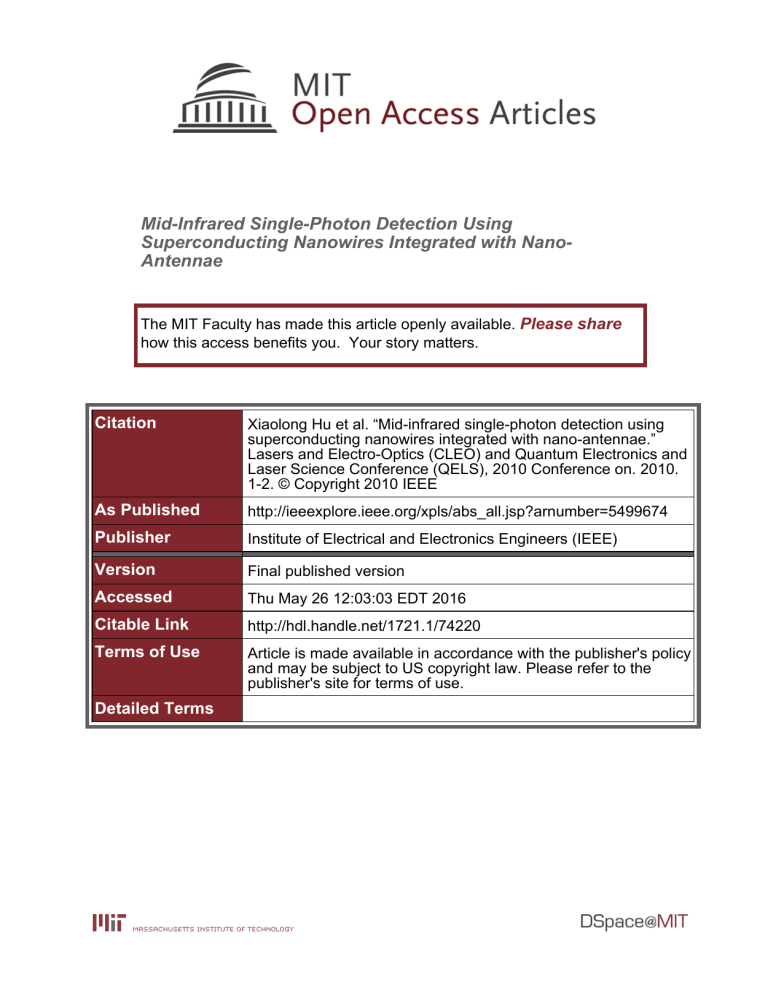
Mid-Infrared Single-Photon Detection Using
Superconducting Nanowires Integrated with Nano-
Antennae
The MIT Faculty has made this article openly available.
Please share
how this access benefits you. Your story matters.
Citation
As Published
Publisher
Version
Accessed
Citable Link
Terms of Use
Detailed Terms
Xiaolong Hu et al. “Mid-infrared single-photon detection using superconducting nanowires integrated with nano-antennae.”
Lasers and Electro-Optics (CLEO) and Quantum Electronics and
Laser Science Conference (QELS), 2010 Conference on. 2010.
1-2. © Copyright 2010 IEEE http://ieeexplore.ieee.org/xpls/abs_all.jsp?arnumber=5499674
Institute of Electrical and Electronics Engineers (IEEE)
Final published version
Thu May 26 12:03:03 EDT 2016 http://hdl.handle.net/1721.1/74220
Article is made available in accordance with the publisher's policy and may be subject to US copyright law. Please refer to the publisher's site for terms of use.
OSA / CLEO/QELS 2010
QThD5.pdf
Mid-Infrared Single-Photon Detection Using
Superconducting Nanowires Integrated with Nano-Antennae
Xiaolong Hu, 1* Francesco Marsili, 1 Faraz Najafi, 1 and Karl K. Berggren 1*
1 Research Laboratory of Electronics,, Massachusetts Institute of Technology,77 Massachusetts Avenue, Cambridge, Massachusetts 02139, USA
*Corresponding author: xlhu@mit.edu, berggren@mit.edu
Abstract: We present some major challenges of mid-infrared superconducting nanowire single-photon detector technology and our device design with nano-antenna integration to address these challenges.
©2010 Optical Society of America
OCIS codes: (040.5160) Photodetector, (050.6624) Subwavelength structures .
Mid-infrared (Mid-IR) photo-detection is important in applications such as astronomy and environmental monitoring. The red-shift effect puts many nominally visible spectral lines into the IR and mid-IR spectral region, and many vibrational and rotational resonance in complex molecules can be sensed and detected remotely. Niobium nitride (NbN) superconducting nanowire single-photon detectors (SNSPDs) [1] are an emerging, ultrasensitive IR photon counting technology. Some applications at IR telecom wavelengths 1.3 μ m and 1.5 μ m have already been demonstrated. However, the device efficiency of SNSPDs drops dramatically at longer wavelengths. This drop in efficiency limits the mid-IR applications of the detector. As we experimentally observed that the drop of detection efficiency when decreasing the bias current was less for a narrower nanowire (20 -30 nm) than a wider nanowire
(100 nm), according to the hot-spot model, we expect that narrower nanowires are more sensitive to a photon with smaller energy. Therefore, it is natural to think of using narrow nanowires, with a width of 20 - 30 nm, to detect and sense mid-IR photons.
However, several technical challenges associated with mid-IR SNSPDs must be addressed. First of all, the diffraction-limited spot-size increases with wavelength. Thus practical applications require a larger active area in order to couple the mid-IR radiation into the detector efficiently. Second, using a narrower nanowire to cover a larger active area with the typical filling factor of 50%, we inevitably need to increase the length of the nanowire, resulting in a larger kinetic inductance and a lower speed. Speed is considered to be one of the major advantages of
SNSPD technology. Finally, the absorption of NbN is weaker in mid-IR spectrum region than telecom spectrum region.
We designed mid-IR SNSPDs integrated with nano-antennae to address the challenges mentioned above. The cross section of the device is shown in Fig. 1 (a) schematically. The key element added to the cavity-integrated detector [2] is a one dimensional gold grating, shown between the two dashed lines in Fig. 1 (a). The gold grating lines behave as antennae, which can effectively collect the transverse-magnetically- (TM-) polarized mid-IR radiation and focus it onto NbN nanowire. The cavity length, L , is defined as the distance from the top of hydrogen silsesquioxane (HSQ) grating to the top of sapphire substrate.
Fig. 1. Mid-infrared superconducting nanowire single-photon detector integrated with nano-antennae. (a) Device cross section (not to scale). The wire width is 30 nm; (b) simulated absorptance for TM-polarization vs. cavity length at the wavelength of 4 μ m; (c) simulated optimized cavity length and corresponding absorption for different wavelengths. The lines are used for guiding eyes.
To illustrate the principle, in our design and simulation we used the wavelength of 4 μ m, a nanowire width of
30 nm, and a meander pitch of 100 nm. In addition, there is a 2-nm thick NbNO x
oxide layer on top of NbN.
Because NbN and gold are dispersive at the wavelength of interest, we used the Drude model to fit the experimental data from 300 nm to 1700 nm that we measured by ellipsometry for NbN, and fit the experimental data from the
978-1-55752-890-2/10/$26.00 ©2010 IEEE 1
OSA / CLEO/QELS 2010
QThD5.pdf handbook [3] for gold. In this way, we can obtain their optical constants at any given wavelength of interest, and specifically at 4 μ m, we obtained complex optical indices 9.01+ i 9.61 for NbN and 3.18+ i 28.48 for gold. For all the dielectrics, we assumed that they are non-dispersive, and optical constants at 1.55 μ m were used [4]. We optimized the cavity length L in order to obtain resonance and maximize the absorptance of NbN. As shown in Fig. 1 (b), the optimized cavity length is at ~500 nm, and remarkably, the peak absorptance is ~ 82% for TM-polarized incident light. Furthermore, this absorptance is not very sensitive to the actual cavity length. For instance, the absorptance is still ~76% when the cavity length is decreased to 350 nm. As a comparison, without nano-antennae and with only top reflector integration [2], the nanowire is more sensitive to TE-polarization, and the optimized absorptance is
51%. The optimized cavity length and the corresponding absorptance for different wavelengths are shown in
Fig. 1 (c). As expected, the optimized cavity length becomes longer for longer wavelength. The slightly drop in optimized absorption at longer wavelength is due to the fact that the frequency of the radiation is further away from the plasma frequency of NbN and thus its absorption becomes weaker.
We can increase the active area of the detector by increasing the pitch of the meander and sacrificing some absorption. Considering of the wavelength of 4 μ m again and increasing the pitch of the meander to 200 nm, for example, the absorptance decreases to 57%. However, increasing the pitch and doubling the detector area would make coupling more efficient. Thus, an optimized pitch exists for practical applications from the point of view of system detection efficiency that balances coupling efficiency against absorption. Note that while the pitch is being changed, the length and the width of the detector have not been changed. Therefore, the speed of the detector has not been affected.
We optimized the process [2] and successfully fabricated nanowire structures as narrow as 34 nm using 45-nm thin HSQ and 30 keV scanning-electron-beam lithography. Scanning electron microscopic inspection showed that the nanowires were uniform in width and smooth at the edges, as shown in Fig. 2.
34 nm
Fig. 2 Fabricated ultra-narrow nanowire resist structure with a width of 34 nm and smooth edges for mid-infrared detection.
In order to realize the device structure shown in Fig. 1 (a), we will need to slightly modify the fabrication process to fabricate a taller HSQ grating with a uniform width and smooth edges. We propose to use thicker HSQ and increase the electron energy to 100 keV in lithography so that the scattering of electrons in HSQ will be significantly reduced. We expect that ~30 nm wide, a 300 - 500 nm tall HSQ grating can be fabricated. After fabricating the HSQ grating, we will spin ~1.5 μ m S1813 photoresist and open a window lithographically aligned with the devices followed by evaporation of SiO
2
/Ti/gold and liftoff.
In summary, we have presented some major challenges of mid-IR SNSPD technology. Once the nanowires become narrower and the wavelength of the radiation becomes longer, some new problems, concerning the active area, speed, and absorption, emerge. We have presented our design for a SNSPD with antenna integration to address these challenges, and we have successfully fabricated nanowire structures as narrow as 34 nm with smooth edges. we have also outlined the fabrication process that will be the next step to realize the designed structure with antenna integration. We believe that with antenna integration, SNSPDs will become a promising technology for efficient mid-IR single-photon detection.
This work is supported by National Science Foundation. Patterning of the detector was done in MIT’s shared scanning-electron-beam lithography facility.
References
[1] G. N. Gol'tsman, O. Okunev, G. Chulkova, A. Lipatov, A. Semenov, K. Smirnov, B. Voronov, A. Dzardanov, C. Williams and Roman
Sobolewski, “Picosecond superconducting single-photon optical detector”, Appl. Phys. Lett.
79 , 705-707 (2001).
[2] K. M. Rosfjord, J. K. W. Yang, E. A. Dauler, A. J. Kerman, V. Anant, B. M. Voronov, G. N. Gol'tsman, and K. K. Berggren, “Nanowire single-photon detector with an integrated optical cavity and anti-reflection coating”, Opt. Express 14 , 527 (2006).
[3] D. W. Lynch and W. R. Hunter, in Handbook of Optical Constants of Solids , edited by E. D. Palik (Academic, San Diego, CA, 1985), I, pp.
275–368.
[4] X. Hu, C. W. Holzwarth, D. Masciarelli, E. A. Dauler, and K. K. Berggren, "Efficiently coupling light to superconducting nanowire singlephoton detectors", IEEE Transactions on Applied Superconductivity 19 , 336 -340 (2009).
2

